#aeronautics
Text
Soaring into Aerospace: NASA Interns Take Flight at EAA AirVenture Oshkosh
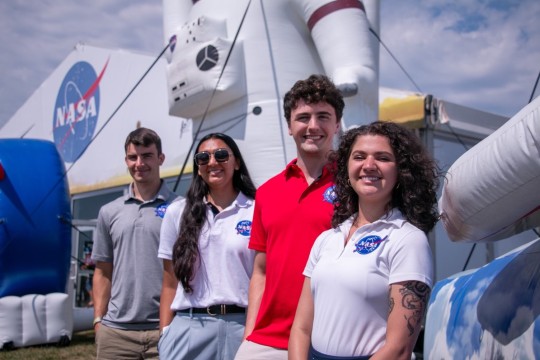
Sustainable Aviation Ambassadors Alex Kehler, Bianca Legeza-Narvaez, Evan Gotchel, and Janki Patel pose in front of the NASA Pavilion at EAA AirVenture Oshkosh.
It’s that time of year again–EAA AirVenture Oshkosh is underway!
Boasting more than 650,000 visitors annually, EAA AirVenture Oshkosh, or “Oshkosh” for short, is an airshow and fly-in held by the Experimental Aircraft Association (EAA). Each year, flight enthusiasts and professionals from around the world converge on Oshkosh, Wisconsin, to engage with industry-leading organizations and businesses and celebrate past, present, and future innovation in aviation.
This year, four NASA interns with the Electrified Powertrain Flight Demonstration (EPFD) project count themselves among those 650,000+ visitors, having the unique opportunity to get firsthand experience with all things aerospace at Oshkosh.
Alex Kehler, Bianca Legeza-Narvaez, Evan Gotchel, and Janki Patel are Sustainable Aviation Ambassadors supporting the EPFD project, which conducts tests of hybrid electric aircraft that use electric aircraft propulsion technologies to enable a new generation of electric-powered aircraft. The focus of Alex, Bianca, Evan, and Janki’s internships cover everything from strategic communications to engineering, and they typically do their work using a laptop. But at Oshkosh, they have a special, more hands-on task: data collection.
“At Oshkosh, I am doing some data collection to better estimate how we can be prepared in the future,” said Janki, an Aerospace Engineering major from the University of Michigan. “Coming to Oshkosh has been an amazing experience… I can walk around and see people passionate about the work they do.”
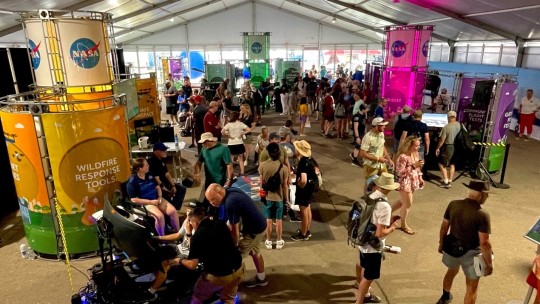
The NASA Pavilion at EAA AirVenture Oshkosh is full of interactive exhibits and activities for visitors to engage with. NASA Interns Alex, Bianca, Evan, and Janki are collecting data in the pavilion to help improve future exhibits at Oshkosh.
In addition to gathering data to help inform future NASA exhibits and activities at Oshkosh, the interns also have the opportunity to engage with visitors and share their passion for aviation with other aero enthusiasts. For Evan, who is receiving his Master's in Aerospace Engineering from the Georgia Institute of Technology, “being able to be here and talk with people who are both young and old who are interested in what the future of flight could be has been so incredible.”
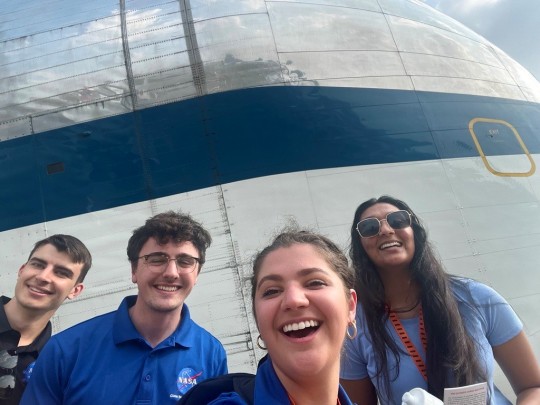
Alex, Evan, Bianca, and Janki pose in front of NASA’s Super Guppy, a specialized aircraft used to transport oversized cargo.
At Oshkosh, one memory in particular stands out for Alex, Bianca, Evan, and Janki: seeing NASA’s famous Super Guppy in person. With a unique hinged nose and a cargo area that's 25 feet in diameter and 111 feet long, the Super Guppy can carry oversized cargo that is impossible to transport with other cargo aircraft.
“We had a very lucky experience… We were able to not only see the Super Guppy, we got to get up close when it landed,” said Bianca, who is receiving her Master's in Business Administration with a specialization in Strategic Communications from Bowling Green State University. “From a learning experience, it gave me a way better basis on cargo aircraft and how they operate.”
For Alex, who is receiving his Master's in Aeronautical Engineering from the Georgia Institute of Technology, it was exciting to see the Super Guppy’s older technology integrated with newer technologies up close. “There have been a lot of good memories, but I think the best one was the Super Guppy. It was cool to see this combination of 60’s and 70’s technology with this upgraded plane.”
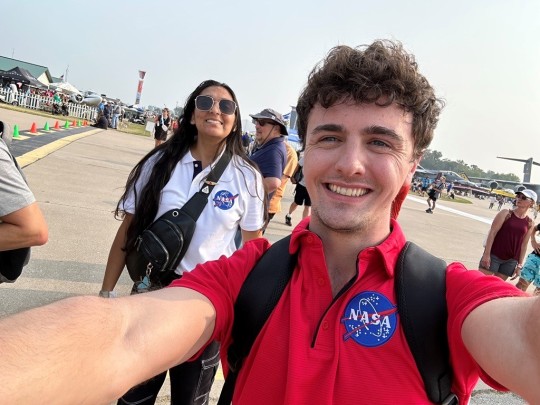
Evan and Janki pose for a photo while walking around EAA AirVenture Oshkosh.
With Oshkosh coming to a close this Sunday, July 30, Alex, Bianca, Evan, and Janki also reflected on advice they have for future NASA interns on how they can get the most out of their internship: be curious and explore, connect with people who work in the field you’re interested in, and don’t be afraid to ask questions.
Alex advises potential NASA interns to “dream big and shoot for your goals, and divide that up into steps… In the end it will work out.” For Bianca, being open and exploring is key: “take opportunities, even if it’s the complete opposite thing that you were intending to do.”
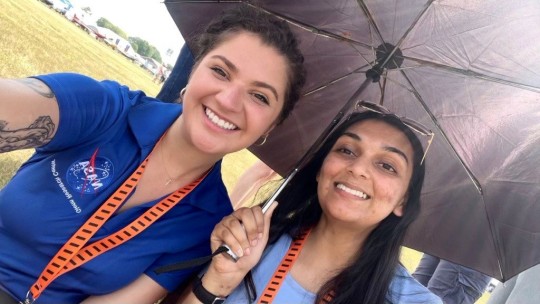
“Ask questions all the time,” said Evan. “Even outside the internship, always continue asking people about what they are knowledgeable on.” And Janki encourages future interns to “Follow your own path. Get the help of mentors, but still do your own thing.”
Visiting Oshkosh and want to see NASA science in action? Stop by the NASA Pavilion, located at Aviation Gateway Park, and see everything from interactive exhibits on sustainable aviation, Advanced Air Mobility, Quesst, and Artemis to STEM activities–and you may even meet NASA pilots, engineers, and astronauts! At Oshkosh, the sky’s the limit.
Interested in interning with NASA? Head over to NASA’s internship website to learn more about internship opportunities with NASA and find your place in (aero)space.
Make sure to follow us on Tumblr for your regular dose of space!
#aeronautics#NASA#aviation#airplane#internships#airventure#intern#work advice#advice#avgeek#aircraft
908 notes
·
View notes
Text
Reapproaching Supersonic Air Travel

Before the Concorde even began regular flights, protests over its sound levels caused the U.S. and many other countries to ban overland commercial supersonic flight. Those restrictions have stood for fifty years. (Image credit: NASA; via Physics Today)
Read the full article
#aeronautics#CFD#computational fluid dynamics#fluid dynamics#physics#science#shockwave#sonic boom#supersonic
41 notes
·
View notes
Text
Fratelli Alinari · Julhes' aerostat

Fratelli Alinari ~ Hot-air balloon, piloted by the aeronaut Julhes, 1884. From the Exhibition: Fratelli Alinari: A Photographic Tradition
view more on wordPress

Fratelli Alinari ~ Mister Julhes' ascension in a balloon, Florence, 1905. From: Italy : one hundred years of photography (Susan Sontag and Cesare Colombo), 1988 (front cover) | src internet archive
view more on wordPress
#Fratelli Alinari#hot air balloon#aeronautics#aeronaut#aerostat#aerostats#albumen print#aviation#early aeronautics#flying#Alinari Brothers#Julhes#1880s#1900s#balloon
169 notes
·
View notes
Text

Tullio Crali
Incuneandosi nell'abitato
1934
#aeropittura#Tullio Crali#italian art#italian artist#italian painter#italian painting#italian futurism#futurism#futuristic#italian futurists#airplanes#aviation#aeronautics#flight#small plane#cityscape#modern art#art history#aesthetictumblr#tumblraesthetic#tumblrpic#tumblrpictures#tumblr art#tumblrstyle#artists on tumblr#aesthetic#beauty
125 notes
·
View notes
Photo

Jacques-Henri Lartigue. Zissou takes off his ‘ZYX 24’. Rouzat. 1910
Follow my new AI-related project «Collective memories»
#BW#Black and White#Preto e Branco#Noir et Blanc#黒と白#Schwarzweiß#retro#vintage#Jacques-Henri Lartigue#Zissou#ZYX 24#Rouzat#1910#1910s#10s#aviation#aviation history#planes#aeroplanes#aeronautics
52 notes
·
View notes
Photo
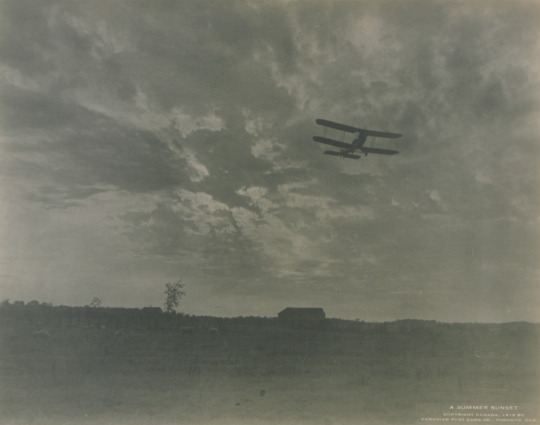
A Summer Sunset, 1919
66 notes
·
View notes
Photo
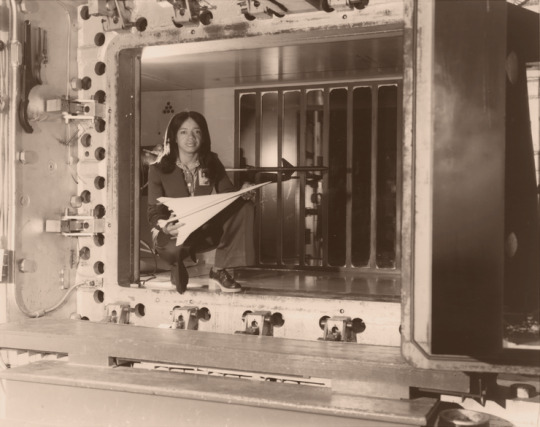
Aeronautical engineer Christine Darden, NASA Langley Research Center, Hampton, Virginia, 1976.
#science#aeronautics#engineering#Christine Darden#NASA#Langley Research Center#Hampton#Virginia#USA#1976
163 notes
·
View notes
Photo
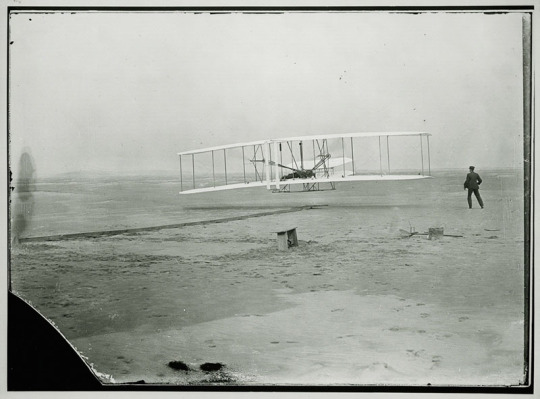
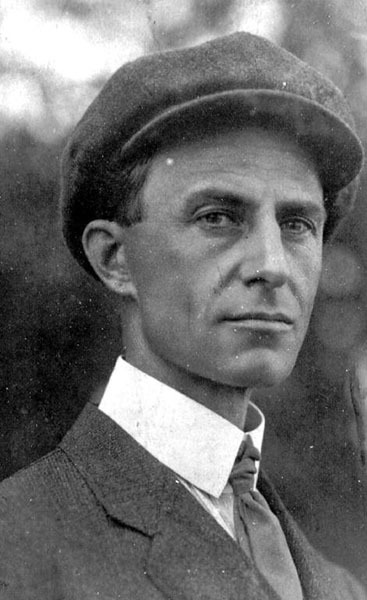



Wilbur Wright – Scientist of the Day
Wilbur Wright, the elder of the aviating brothers, died May 30, 1912, at age 45.
read more...
#Wilbur Wright#aeronautics#flight#aircraft#histsci#histSTM#20th century#history of science#Ashworth#Scientist of the Day
61 notes
·
View notes
Link
NASA is awarding $11.7 million to eight Historically Black Colleges and Universities (HBCUs) through the new Data Science Equity, Access, and Priority in Research and Education (DEAP) opportunity. These awards will enable HBCU students and faculty to conduct innovative data science research that contributes to NASA’s missions.
“We’re pleased to make progress through awards like this to intentionally build the STEM pipeline of the future, especially in communities of color,” said NASA Deputy Administrator Pam Melroy. “It’s fitting during Black History Month that we make this tangible step to build on the talent pool at HBCUs in our ongoing work to bring to the table all the talents and perspectives we’ll need to send humans to the Moon, Mars and beyond, and do amazing science throughout the solar system.”
Continue Reading
94 notes
·
View notes
Text
A Beginner’s Guide to Advanced Air Mobility

Soaring over traffic in an air taxi, receiving packages faster, and participating in a sustainable, safer mode of transportation: all could be possible with a revolutionary new type of air transportation system in development called Advanced Air Mobility (AAM).
AAM could include new aircraft developed by industry, called electric vertical takeoff and landing vehicles, or eVTOLs, for use in passenger, package, or cargo delivery. It may also include new places for these aircraft to take off and land called vertiports.
Our work in Advanced Air Mobility will transform the way people and goods will move through the skies. This includes using Advanced Air Mobility for public good missions such as disaster, medical, and wildfire response.
What is Advanced Air Mobility?
Our vision for Advanced Air Mobility is to map out a safe, accessible, and affordable new air transportation system alongside industry, community partners, and the Federal Aviation Administration.

Once developed, passengers and cargo will travel on-demand in innovative, automated aircraft called eVTOLs, across town, between neighboring cities, or to other locations typically accessed today by car.
What are the benefits of Advanced Air Mobility?
The addition of Advanced Air Mobility will benefit the public in several ways: easier access for travelers between rural, suburban, and urban communities; rapid package delivery; reduced commute times; disaster response, and new solutions for medical transport of passengers and supplies.
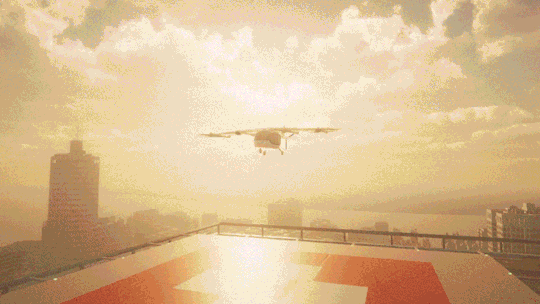
What are the challenges associated with Advanced Air Mobility?
Various NASA simulation and flight testing efforts will study noise, automation, safety, vertiports, airspace development and operations, infrastructure, and ride quality, along with other focus areas like community integration.
These areas all need to be further researched before Advanced Air Mobility could be integrated into our skies. We’re helping emerging aviation markets navigate the creation of this new transportation system.
When will Advanced Air Mobility take off?
We provide various test results to the FAA to help with new policy and standards creation. We aim to give industry and the FAA recommendations for requirements to build a scalable Advanced Air Mobility system to help enable the industry to flourish by 2030.

Make sure to follow us on Tumblr for your regular dose of space!
#travel#sustainability#aircraft#NASA#aeronautics#aviation#flight#technology#transportation#tech#NationalDroneDay
1K notes
·
View notes
Text
Watching real genius made me miss aeronautical engineering
14 notes
·
View notes
Text

Tullio Crali
Before the Parachute Opens (Prima che si apra il paracadute)
1939
#Tullio Crali#aeropittura#aeropainting#futurism#futurist#italian futurism#italian art#italian painter#italian painting#italian artist#airplane#aviation#aeronautics#aesthetic#beauty#modern art#art history#aesthetictumblr#tumblraesthetic#tumblrpic#tumblrpictures#tumblr art#tumblrstyle#artists on tumblr#skydiving
82 notes
·
View notes
Text
Mars Sample Return a top scientific priority, Lunine testifies - Technology Org
New Post has been published on https://thedigitalinsider.com/mars-sample-return-a-top-scientific-priority-lunine-testifies-technology-org/
Mars Sample Return a top scientific priority, Lunine testifies - Technology Org


At the western end of Mars’ Jezero Crater, a river channel and pile of sediments resembling river deltas on Earth hold clues about how Mars evolved from a more Earth-like world to the barren, inhospitable surface seen today.
Since 2021, NASA’s Perseverance rover has collected more than 20 samples of rocks and sediments from the crater floor, delta fan and hills above it – resources that could answer crucial questions about what happened to the red planet’s climate and geology and improve understanding of our own.
But those samples could be stranded on Mars if Congress fails to provide adequate funding for the space agency to design and build the Mars Sample Return mission, Jonathan Lunine, the David C. Duncan Professor in the Physical Sciences and chair of the Department of Astronomy in the College of Arts and Sciences, testifiedm before a congressional subcommittee reviewing NASA’s science programs.
“The benefit of succeeding in bringing back rock and soil from an ancient riverbed on a planet 140 million miles away is that it will tell the world that this nation has the imagination, will and courage to accomplish just about anything,” Lunine said in written testimony. “And that message is priceless. To not complete Mars Sample Return – to leave the samples stranded on Mars – would be … a national disgrace.”
Lunine was one of four experts invited to testify at the U.S. House Subcommittee on Space and Aeronautics hearing titled, “Advancing Scientific Discovery: Assessing the Status of NASA’s Science Mission Directorate.” Watch a replay here.
Earlier this year, budget uncertainty led NASA to plan for the lower of two proposed funding levels for the mission and to lay off staff at its Jet Propulsion Lab in California. Current appropriations bills defer a decision on funding, which could range from $300 million to nearly $1 billion, while the agency reassesses the mission’s architecture.
Nicola Fox, associate administrator of NASA’s Science Mission Directorate, said that after an independent review board’s “sobering analysis” of the mission’s costs and challenges last fall, the agency would complete its internal reassessment this spring.
“It’s our willingness to acknowledge these challenges and overcome them, to conduct science in ways that have barely been imagined, that makes us NASA,” Fox testified.
Lunine called Mars Sample Return the most ambitious robotic program the United States has ever attempted, requiring challenging new technology and involving multiple NASA centers and the European Space Agency.
But having served as a member of an independent review board that examined the mission last year, Lunine said he’s “supremely confident” that it can and will be done despite budget pressures requiring difficult choices.
“It can be done because American engineering prowess is up to the task,” he told lawmakers. “It will be done because as a nation we surely will not simply walk away from a daring, highly visible and scientifically important challenge.”
Successive National Academies of Sciences decadal surveys have identified the mission as the top priority in planetary science, Lunine said, to help answer the questions: Did life begin on Mars? How did Mars dry up? Exactly when did it dry up?
Only instruments in laboratories on Earth, instruments far more precise and powerful than those carried by the Mars rovers, can precisely analyze the collected rock and soil samples to determine their composition and age, Lunine said. In the same way, the samples Apollo astronauts returned from the moon established a definitive chronology for the earliest history of the Earth-moon system – the program’s most profound scientific achievement, Lunine said. More than a half-century later, moon samples continue to be studied by increasingly capable instruments.
“The samples returned from Mars in the coming decade will be analyzed not only by scientists active today, but by scientists who are not yet born, using laboratory techniques not yet invented,” Lunine said. “These precious records of early Mars will be a lasting scientific treasure and a legacy of American technological prowess.”
Source: Cornell University
Mars gifts – the best space gifts from the Red Planet, ranging from Mars-themed clothes to genuine, certified meteorites from Mars.
#aeronautics#Analysis#architecture#Arts#astronauts#Astronomy#Astronomy news#billion#board#Born#challenge#channel#climate#college#Composition#Design#earth#engineering#European Space Agency#Funding#Geology#hearing#History#how#it#LED#life#mars#Mars rovers#message
5 notes
·
View notes
Text

Hi there!
everybody aboard?
ready to time-travel to 2023?
original image: Original-Photographien des Gordon Bennett Cup in Warschau. Um 1935. [JVV Auktionen]
#vintage photography#2023#welcome#1930s#hot air balloon#flying#early aviation#early aeronautics#aviation#balloon#aeronautics
66 notes
·
View notes
